Mystery author Eric Mayer* mentioned in a recent blog post that his blog journaling hasn’t been very habitual of late. He went on to write about habits, and that got me to thinking about my habits, and how they’ve changed in the past year or so. Obviously, for me, blogging has taken a back seat to other things. So has my fiction writing, other than attempting to sell my latest finished manuscript, a mystery about a tarot reader whose awakening ability as a medium gets her involved in a murder investigation. (Interested agents or publishers are welcome to inquire here.)
Habits can be good or bad, and I’m sure everyone has some bad ones they’d like to unload. But one new habit I’m happy to have taken on this year is gardening.
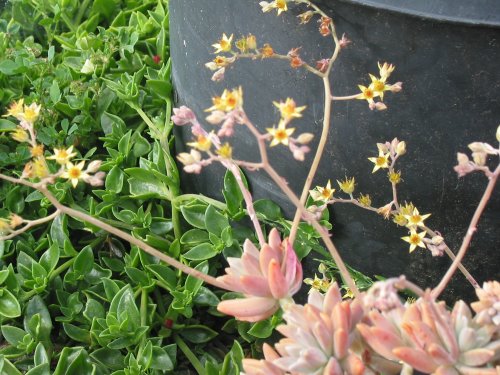
Gardening is indeed a habit, one that gets into your blood in a way I didn’t anticipate when I started out this year. I’d done a tiny bit of gardening as a kid, when I remember planting one rose bush of my own but mostly helping my grandmother with her strawberries and vegetables on the embankment behind my parents’ house. Later, in my first apartment, I nurtured a few houseplants, and throughout my work life I’ve usually kept a potted plant on my desk. I kept African Violets in a north facing window in the last house we rented, until a cat took over that window sill. Still, my husband did most of the outdoor gardening, with a little weeding here and there on my part, until March of this year.
It started this spring with tending a few vegetable and flower seeds until they sprouted, and then the seedlings until they went into the ground. From there I progressed to caring for plants in the ground and preparing the soil for more of them. It’s rapidly expanding to a succession of all of these things, in the hopes of keeping some fresh produce in our salad and veggie bowls through this summer, as well as brightening a corner of the front yard, where my ultimate goal is to keep flowers blooming in a little cottage style bed year round. I’m a ways from that goal yet.
I’m still new at this, and I got a late start this year, but I get help and advice from various sources, and gardening is now a firm habit that I won’t easily give up. It’s one of the first things I think about in the morning and one of the last I think about before the sun goes down.
The plants seem happy about my gardening habit, when they can figure out what season it is. Our weather this spring switched back and forth for a couple of months from one extreme to the other, first dry Santa Anas with temperatures in the 90s, and then thick cloud cover and a shifting Jet Stream chilled the air to the 50s. This went back and forth for weeks, with little pleasant weather in between, and it kept our plants confused. In the past two weeks the weather has leveled off, and the plants are loving it.
They say beauty is in the eyes of the beholder, and I’ve recently realized there’s little more beautiful to me than a tiny plant bursting out of its seed container. Call me crazy, but I think baby plants can be almost as cute as a kitten, and they, like the kitten, draw out my mothering tendencies.
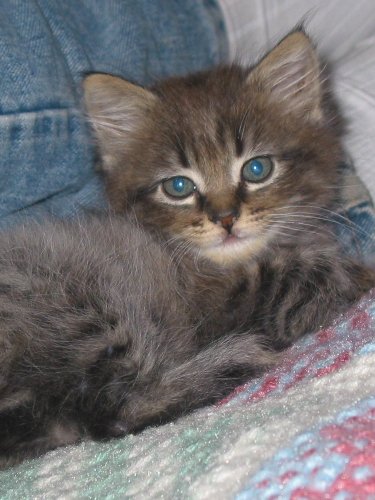
(I’ll bet you expected a photo of a seedling, but I couldn’t help the obligatory kitten shot.)
To some this pleasure might seem like taking joy in watching paint dry, but to me it’s more like watching a sunset at the end of a heat wave.

We celebrated our first avocado blooms a few months ago.
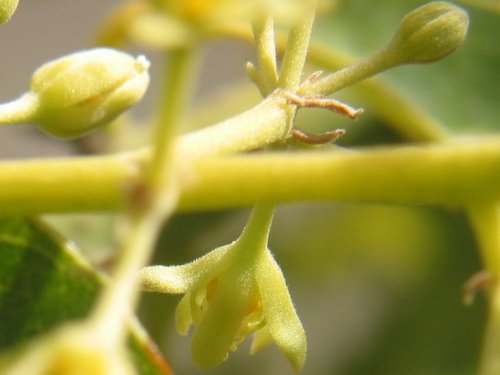
Now some fruit has set, which we hope will grow to maturity.
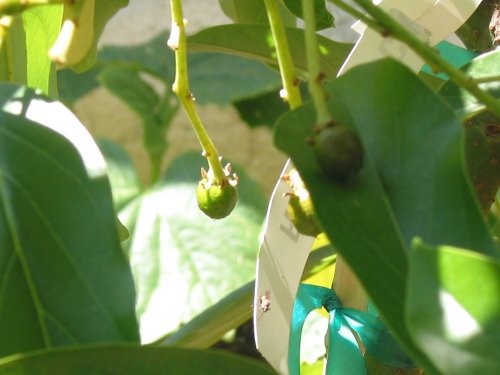
Avocados, according to my resident expert Ken who’s read something like 200 online agricultural reports about them, tend to drop a good portion of their fruit early, which can be disappointing to home gardeners. It will be disappointing to me, if it happens, because Reeds are my absolute favorite avocado variety.
Two days ago I celebrated my first squash blossom.
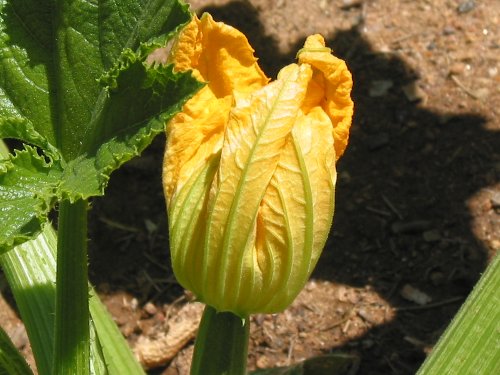
Zucchini may seem an ordinary thing to seasoned gardeners. It’s one of the easiest things to grow and the butt of gardening jokes, usually in reference to an overabundance of it. But I like zucchini, I love my resplendent squash plants with their huge green leaves, and those yellow-orange blossoms are gold to me.
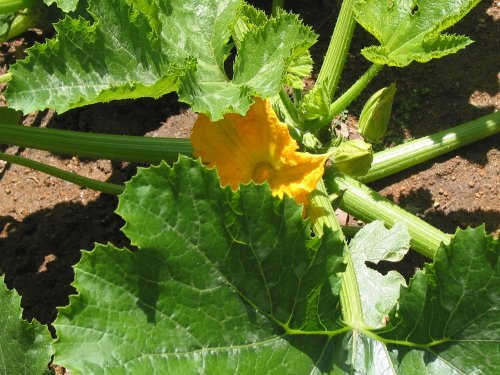
I’m learning more about the various weeds that grow in the garden, some of which are edible. For instance, purslane and dandelion make delicious salad greens. Note, if you decide to try eating weeds from your garden, be careful that you know what you’re eating. Ensure that the plants haven’t been subjected to herbicides or pesticides and that they aren’t in fact toxic weeds.
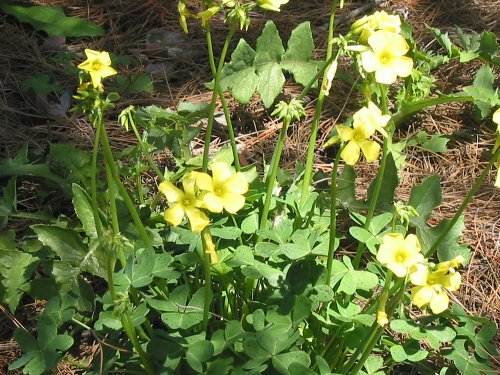
Even some semi-edible weeds, like the sour grass we all discovered as kids, can be a problem if eaten in quantity, I’m told, and purslane looks very similar to a toxic type of spurge that often grows right alongside it. Have an expert show you how to identify edible weeds, and examine carefully whatever you pick to eat. This point was driven home to me when I found spurge, with its milky sap, growing in my own little purslane patch.
Yesterday Ken pointed me to a Los Angeles Times article about Guerrilla Gardeners, which linked to a slide show on how to make “seed bombs” as well as two blogs, here and here, about guerrilla gardening.
Gardening has not only revolutionized my daily routine. It’s apparently a revolution that’s spreading once again, as Victory Gardens did in the last century, with people today gardening to save money on local food and working on a clandestine volunteer basis to re-green the land.
_ _ _
* In case you aren’t aware, Eric Mayer and Mary Reed’s latest John the Eunuch Byzantine mystery, Seven For A Secret, was released in April by Poisoned Pen Press. If you haven’t kept up with their historical mystery series, it’s not too late to start. The earlier books in the series are still in print, and some are now available as Kindle editions.
This is a political and diplomatic soup I never expected as a result of global warming, but I never was all that good at chess either.
Political dramas are playing out over the Northwest Passage, igniting fresh strife regarding who owns northern waters and the numerous islands that are revealed as ice melts.
If you’d like a look at what’s happening by way of the now-familiar backward chronology of a blog, check out BBC News’ Diary: Taking the Northwest Passage. It chronicles an actual passage by David Shukman on board ship with the Canadian Coast Guard. He includes information about the disputes that have risen in the past and may again in the near future. Shukman also answers questions from readers, with the help of Professor Jean-Eric Tremblay, the chief scientist of the expedition, in Northwest Passage: Your questions answered.
If you wonder how much global warming could change your nearest coastline in the next two decades, take a look at ABC’s What Global Warming Looks Like. It features the work of Edward Mazria, an architect who turned to spreading information about global warming and the contribution to it by the building industry. He’s produced a set of images showing what he predicts some large coastal cities in the US will look like in 2030, with projected rising water levels due to global warming.
Thanks to Georganna Hancock at A Writer’s Edge, for her post, Writing on Blog Action Day, and its heads-up that today is Blog Action Day for the Environment.
Has it been more than a week already since I posted? I lost track of time during my panic of the past few days. The other night, after a glitch occurred when I ran my backup program, I thought I’d lost all my files for my current book in progress. Panic ensued, while I scrambled to find and undelete the files. I spent almost 24 hours straight on that, with little sleep, piecing together fragmented files, hoping I still had a complete book there. Finally I came across the directory on the backup computer where my backup program had stored a complete second archive of everything — perfectly intact and up to date, including every last minute of my work on the book.
All that panic because I was too dumb to know my backup program stored an archive of deleted files, and because I had allowed too much other garbage to backlog on my hard drive. (The glitch occurred when that particular hard drive filled up.)
I could sit here and ask why me, or rather ask why I do this to myself, but I’m too busy getting back to normal and on with work. Still, it seems that I go through this sort of panic on a regular basis. It happened two years ago when my old laptop gave out and I lost work that I hadn’t yet backed up. This time it resulted from the backup process itself.
Once I’m finished with this book and it’s off getting a look by some agents, I plan to spend a few weeks getting my life in better order, including both paper and digital files, to prevent future panic episodes.
But one thing I noticed during all of this was that I don’t tend to print out what I’ve written as often as I used to. In spite of what might’ve been lost, overall I consider that a good thing, a good sign that I’m making my personal transition from paper to a digital world.
I admit to some affection for the paper world. It’s what I grew up with, and where I found my love of books and the written word. There is still something sensual to me about the feeling of pen and paper or a book in my hands. I like the shape of the book, the weight of it, the toothy or smooth texture of paper, even the smell of ink, paper, and binding materials. I still recall with nostalgia the particular smell of the book I was handed in third or fourth grade when we studied the culture and geography of Japan. Ever since, I’ve looked for similar qualities each time I open a new book. All these things make letting go of the paper world a clingy process.
At the same time, I love trees. Because of that, I’ve always been troubled that my chosen form of expression — writing — has a history of felling so many trees. So when I went through my computer files and some paper files over the past few days, I was pleased to realize that I recently have less tendency to print as I write. I used to feel a need to print out what I’d written more frequently, to edit or proofread on paper rather than onscreen, or just to get a sense of what the printed story would look like.
Maybe it’s so many years of writing on a computer that’s changed this. Maybe it’s the laptop’s portability and reduced glare being easier on my eyes. Maybe it’s no longer having a job that requires me to stare at a screen all day and then do the same all my evenings and weekends for my fiction writing.
Maybe it’s blogging. The immediacy of blogging tends to encourage me to edit onscreen. My blog is even set up now so I can view what I write in two or three different fonts before I post it, which I think aids the onscreen editing and proofreading process.
Maybe it’s a combination of all those factors. It’s interesting to note that more publishing venues have opened up to electronic submissions just since the CRT monitor has begun to vanish. Hopefully the less glaring monitors that are replacing them will be much easier on all our eyes, and continue to save more trees.
I still write a good half of my personal journal pages by hand, and I still use handwriting to jump-start or unblock my writing process. This blog post is in fact a segue from my morning pages. But my journal pages don’t get reproduced, except by typing them into a digital format, and they’re unlikely ever to be published in book form. The paper is eventually recycled if they do become digital, so I’m not as concerned about my journal pages killing trees. At least that’s what I like to tell myself.
Now if we can get the ebook technology to the point where fewer paper books have to be printed, at least for popular fiction, then we’ll have made real progress in taking publishing from deforestation for profit to a more pure form of edification, expression, and entertainment. Of course there will always be uses for paper. I can’t think of a better way to keep certain legal documents or accounting records, right now, though that’s not a world I work or have much expertise in. There are also some types of books that just work better, for now, on paper. One that comes to mind is the coffee table variety, with color plates of artwork or photography. But the less trees cut down for paper and books, the better.
Even if what this Guardian Unlimited article says is true, that planting more trees in temperate latitudes won’t help assuage global warming, it also states that destroying more trees isn’t the answer, that the greater need, and indeed our motivation for attempting to slow global warming, is to preserve ecosystems, including but certainly not limited to our own.
Perhaps my panic over my files had some value. It got me not only to change what I file away on my computer and how I back it up, but also to take a hard look at how I use paper, to keep heading along the road I’ve started down, of conserving wherever it’s reasonable, and wherever I can.
Linking the past days together— It’s Super Bowl Sunday, and I didn’t know. Isn’t that usually in January? I don’t pay attention to professional sports, and some years my only clue about when that event occurs is the date they tell you the winner of the Publishers Clearinghouse Sweepstakes will be announced, which doesn’t apply to me, since I don’t enter. If Ed McMahon shows up at my door it’s more likely to be about Neighborhood Watch, or because he just spoke to Johnny Carson and he’s heard I have an interest in contact with the other side. (more…)









